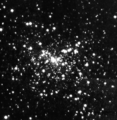| M15 | |
|---|---|
 M15 photographed by Hubble Space Telescope. The planetary nebula Pease 1 can be seen as a fuzzy reddish object near the upper left of this image. | |
| Observation data (J2000 epoch) | |
| Class | IV |
| Constellation | Pegasus |
| Right ascension | 21h 29m 58.38s[1] |
| Declination | +12° 10′ 00.6″[1] |
| Distance | 33.6 kly (10.3 kpc) |
| Apparent magnitude (V) | +6.2 |
| Apparent dimensions (V) | 18′.0 |
| Physical characteristics | |
| Mass | - kg (- M) |
| Radius | ~88 ly[2] |
| VHB | 15.83 |
| Estimated age | - |
| Notable features | steep central cusp |
| Other designations | NGC 7078, GCl 120[1] |
Messier 15 or M15 (also designated NGC 7078) is a w:globular cluster in the w:constellation Pegasus. It was discovered by w:Jean-Dominique Maraldi in w:1746 and included in w:Charles Messier's catalogue of w:comet-like objects in w:1764. At an estimated 13.2 billion years old, it is one of the oldest known globular clusters.
M15 is about 33,600 w:light-years from w:Earth. It has an w:absolute magnitude of -9.2 which translates to a total w:luminosity of 360,000 times that of the w:Sun. Messier 15 is one of the most densely packed globulars known in the w:Milky Way galaxy. Its core has undergone a contraction known as 'w:core collapse' and it has a central density cusp with an enormous number of stars surrounding what may be a central black hole.
Messier 15 contains 112 w:variable stars, a rather high number. It also contains at least 8 w:pulsars, including one double w:neutron star system, M15 C. Moreover, M15 houses w:Pease 1, one of only four w:planetary nebulae known to reside within a globular cluster, which was discovered in w:1928.
To the amateur w:astronomer Messier 15 appears as a fuzzy star in the smallest of w:telescopes. Mid to large size telescopes (at least 6 in./150 mm diameter) will start to reveal individual stars, the brightest of which are of magnitude +12.6.
 The central square arcminute of M15 imaged using the w:lucky imaging technique
The central square arcminute of M15 imaged using the w:lucky imaging technique Messier 15 Amateur Image Courtesy Hunter Wilson
Messier 15 Amateur Image Courtesy Hunter Wilson
External links
References
- 1 2 3 "SIMBAD Astronomical Database". Results for NGC 7078. http://simbad.u-strasbg.fr/Simbad. Retrieved 2006-11-16.
- ↑ distance × sin( diameter_angle / 2 ) = 88 ly. radius
| |||||